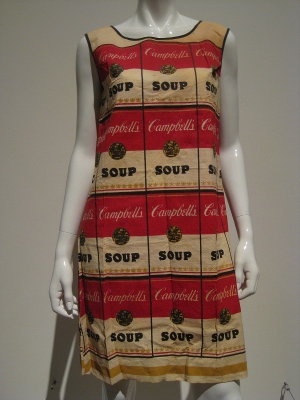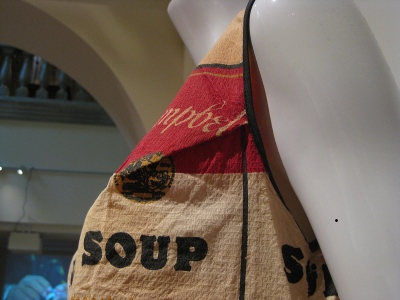Shams, of Communing With Fabric, has a post up today about two surprisingly chic dresses made from candy wrappers, which reminded me of this post, which has been languishing in my queue since February. This particular dress isn’t exactly made from wrappers, but it is made of paper — more or less. The image is, of course, Andy Warhol’s iconic Campbell’s soup can:
I saw it in the Heard Museum in Phoenix, Arizona. According to its website, the Heard is “one of the world’s finest destinations for learning about American Indian arts and cultures”. Where Polish-American Andy, or, for that matter, Campbell’s soup, fits into this mission is unclear, but nevermind . . .
In the late 1960s, soup lovers could acquire this dress by sending in a couple of Campbell’s labels and a small fee (a dollar, I believe).
Note the dart — both placement, and construction:
It’s sort of an interesting take on a one-dart-fits-all approach: The dart is really just a pleat. This works on a mannequin, but I suspect it just “poufed” in the wearing.
The late 60s were a great era for paper clothing. I have a paper sari from around that time which was given to passengers by Air India; it’s rather charming, actually, though, of course, completely impractical as a garment. How times have changed! Now the best you can hope for on a plane is a cardboard sandwich. If you’re lucky.
The Heard Museum seems less like a museum and more like a showcase for contemporary artists whose work is on sale, but that’s not all bad; it’s filled with interesting artifacts, and worth a trip if you find yourself in Arizona — which I hope you don’t, at least until the state legislature acquires some semblance of sanity and does a little productive soul-searching.



The paper dress craze of the 60s baffles me a little. But then I remember that “disposable fashion” made of fabric did not yet exist. The end of the American textile industry certainly took care of that!
Trena, I think part of the paper dress craze was due to the evolving “disposable culture”. When paper tableware first started appearing in the late 50s and 60s, only a really tasteless hostess would offer either to her guests. Paper napkins were a serious etiquette no-no., and disposable utensils and paper plates strictly for picnics. They were just tacky, tacky, tacky. But eventually they gained ground, and people began looking at all sorts of possibilities — I can really see how the edginess of paper dressing could appeal to a designer (not to mention a PR person), especially as the disposable nature of our modern culture began to snowball and grow.
The paper sari I have was a kind of status symbol — flying was expensive then, not many people flew or could afford to, and people dressed up to get on planes; the whole family often went to the gate to see travellers off and to greet them. If you were non-Indian and flying from the US to India, you were elite, and your paper sari was just one more bit of evidence proving that. That sari may have been paper, but it had a lot of cachet! (Not that you’d actually *wear* it, you understand . . . )
That’s a really good point about how disposable clothing has now become. Cheap RTW isn’t meant to last more than one season — and doesn’t. I wouldn’t really consider this progress.
Wow! I wonder how many of these are languishing in basements and attics all over America!?
Yeah, Carolyn, I had the same thought. In the way of these things, some have sold for ridiculous sums of money. Maybe being a pack rat can pay off, after all.